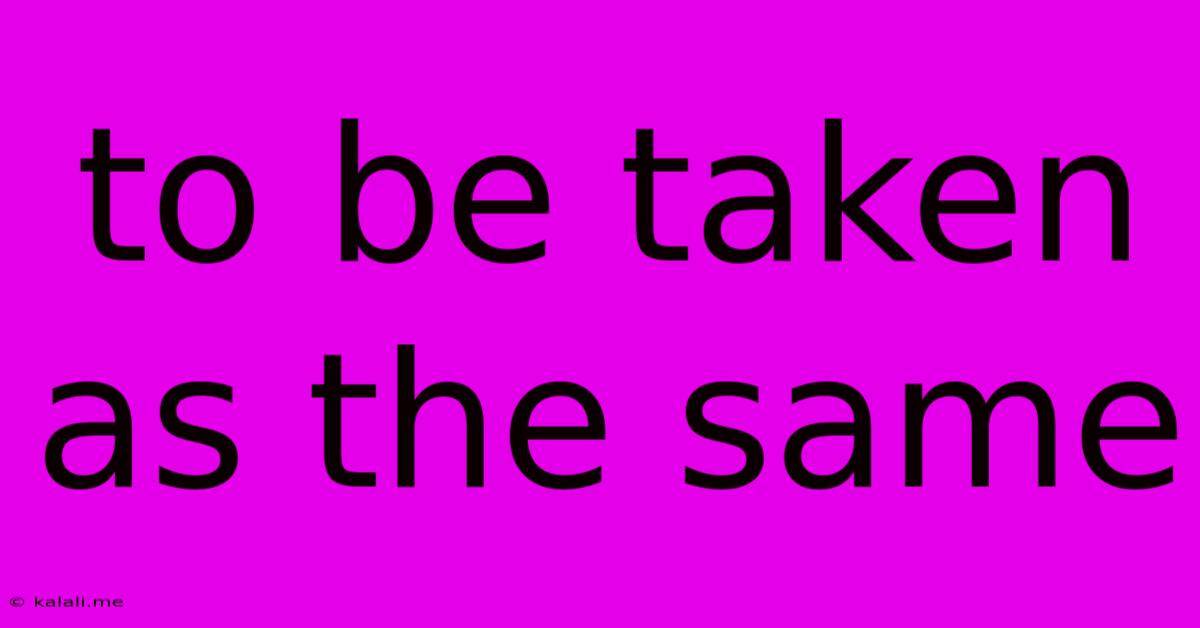To Be Taken As The Same
Kalali
May 19, 2025 · 3 min read

Table of Contents
To Be Taken as the Same: Exploring the Nuances of Equivalence
This article delves into the multifaceted concept of being "taken as the same," exploring its implications across various fields, from philosophy and law to everyday social interactions. We'll examine the subtle differences between true equivalence, perceived equivalence, and the potential consequences of misinterpreting sameness. Understanding this nuanced concept is crucial for clear communication, effective decision-making, and navigating complex social dynamics.
What does "taken as the same" actually mean? At its core, this phrase signifies a perceived or imposed equivalence between two or more entities. This equivalence isn't necessarily rooted in objective reality; it can be a product of simplification, assumption, categorization, or even deliberate manipulation. The context significantly shapes the meaning and implications.
Equivalence in Different Contexts:
-
Legal and Regulatory Frameworks: In law, "taken as the same" might refer to the legal principle of stare decisis, where previous rulings are considered equivalent precedents for similar cases. Regulations often group similar products or services together for streamlined processing, even if minor differences exist. This can lead to debates about whether the “sameness” is justified and fair.
-
Data Analysis and Machine Learning: Algorithms frequently treat data points as equivalent based on shared characteristics, enabling pattern recognition and prediction. However, this simplification can mask important nuances and lead to biased or inaccurate results if the initial assumptions of sameness are flawed. This is particularly relevant in areas like facial recognition technology, where inherent biases can lead to misidentification.
-
Social Interactions and Identity: In social contexts, individuals might be "taken as the same" based on superficial similarities like race, gender, or socioeconomic background. This can lead to stereotyping and prejudice, overlooking individual differences and unique experiences. Conversely, shared values, beliefs, or experiences can also create a sense of equivalence and foster connections.
-
Scientific Research and Measurement: In scientific experiments, the assumption of equivalence is fundamental. Researchers strive to create controlled conditions where variables are "taken as the same" across experimental groups, except for the factor being studied. Any deviation from this equivalence can compromise the validity of the results.
The Dangers of Oversimplification:
Treating things as the same when they are not can lead to serious consequences. Oversimplification can:
-
Mask Inequality: Failing to acknowledge crucial differences can perpetuate systemic inequalities. For instance, assuming all members of a group share the same needs or experiences ignores individual diversity.
-
Create Inaccurate Models: In data analysis and scientific research, inaccurate assumptions about equivalence can lead to flawed conclusions and ineffective solutions.
-
Impede Effective Communication: Assuming shared understanding when it doesn't exist can lead to misunderstandings and conflict.
-
Promote Bias and Discrimination: Categorizing individuals based on superficial similarities without considering individual nuances fosters prejudice and discrimination.
Navigating the Nuances of "Taken as the Same":
To mitigate the risks of misinterpreting sameness, we need to:
- Critically examine assumptions: Question the basis for assuming equivalence and look for evidence to support or refute it.
- Embrace nuance and complexity: Acknowledge and appreciate the diversity and variability within groups and categories.
- Seek diverse perspectives: Engage with different viewpoints to gain a more comprehensive understanding.
- Promote inclusive language and practices: Avoid language that reinforces stereotypes or oversimplifies complex realities.
In conclusion, the concept of "taken as the same" is far more complex than it initially appears. Understanding the context, the potential pitfalls of oversimplification, and the importance of critical thinking is essential for effective communication, ethical decision-making, and building a more equitable and just world. By acknowledging the nuances of equivalence, we can move towards a more accurate and informed understanding of the world around us.
Latest Posts
Latest Posts
-
Fallout 4 Battle For Bunker Hill
May 19, 2025
-
Derivative Of X 2 X 1
May 19, 2025
-
Meaning Of Top Of The Morning
May 19, 2025
-
Did Top Gear Actually Find The Source Of The Nile
May 19, 2025
-
Describing The Letter P In The Word Psychology
May 19, 2025
Related Post
Thank you for visiting our website which covers about To Be Taken As The Same . We hope the information provided has been useful to you. Feel free to contact us if you have any questions or need further assistance. See you next time and don't miss to bookmark.